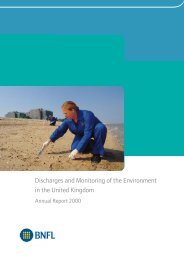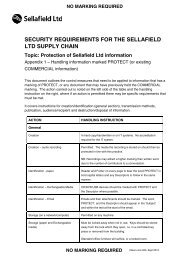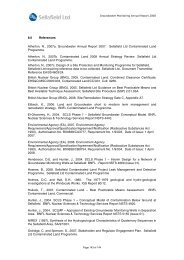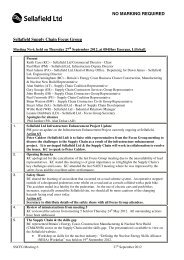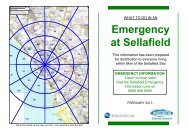Annual Report for 2010/11 and Forward Programme - Sellafield Ltd
Annual Report for 2010/11 and Forward Programme - Sellafield Ltd
Annual Report for 2010/11 and Forward Programme - Sellafield Ltd
Create successful ePaper yourself
Turn your PDF publications into a flip-book with our unique Google optimized e-Paper software.
SSEM/20<strong>11</strong>/4730 June 20<strong>11</strong>accounted in assessing risk <strong>for</strong> the public. Controls <strong>and</strong> measures are applied <strong>for</strong> thesespecific operations to ensure suitable protection of the operators. In that operations to find<strong>and</strong> retrieve objects are on public beaches, a dose level of significance <strong>for</strong> workers is takenas 1 mSv per annum, corresponding to a 5x10 -5 overall fatal risk (ICRP, 2007).5.3.2 InhalationOnce a find is located by the Groundhog systems, the operator needs to remove materialsurrounding the object. Often conditions are inclement, windy, not always wet, <strong>and</strong> so thereis potential <strong>for</strong> material, e.g. s<strong>and</strong>, to become airborne. Calculations on size of respirablematerial show that potential radioactivity associated with the particulate size is low (i.e.approximately 0.1 Bq of actinide activity) <strong>and</strong> presents little hazard unless large numbers ofparticles are inhaled. For example, the inhalation of approximately 375 particles of averagerespirable size is required to give a dose of 1 mSv. This is corroborated by the HPA’sevaluation in their reports (R<strong>and</strong>les, <strong>2010</strong>).A proportion of the particle finds are known to be potentially friable (R<strong>and</strong>les, <strong>2010</strong>). Theseconsist of aggregations of smaller particles that are stable when wet but prone to fragment asthey dry out, particularly when h<strong>and</strong>led directly. The smaller particles will have a range ofsizes with a proportion of them being of respirable size.For an acute inhalation intake, analysing <strong>for</strong> worst case fraction of particles that becomefriable <strong>and</strong> worst case release fraction around the highest alpha-rich find, the calculatedpotential uptake to the operator is an order of magnitude below the significant dose. Even atthis low dose level, several thous<strong>and</strong> particles would need to be present to ensure there aresufficient respirable particles available <strong>for</strong> inhalation.For chronic inhalation uptake, analysis follows average activities, friability <strong>and</strong> releasefractions <strong>and</strong> results indicate that there is potential <strong>for</strong> uptake via this route that couldmarginally exceed 1 mSv per annum. This worse case assumption requires that most, if notall, particles are friable <strong>and</strong> their recovery generates sufficient respirable-size particles toallow a small number to be inhaled.However, natural mitigation is that beach materials are often wet <strong>and</strong> it is unlikely that themajority of finds dry out during recovery. Operational mitigation includes the requirement towet the material around a find zone, to reduce the risk of friability <strong>and</strong> there<strong>for</strong>e significantlyreduce the risk of chronic inhalation. An internal dosimetry regime <strong>for</strong> operators is also inplace to monitor this potential (<strong>and</strong> any ingestion potentials detailed below). Environmentalchronic inhalation uptake <strong>for</strong> operators is calculated to be more than 3 orders of magnitudeless than significant dose (R<strong>and</strong>les, <strong>2010</strong>).5.3.3 IngestionWhereas the HPA reports recognise a potential (albeit very unlikely) <strong>for</strong> inadvertent orintended ingestion of radioactive objects by some categories of the public, operators do notfall into these person categories. Nevertheless, operators spend more time on the beachesthan members of the public (around 1200 h per annum). Calculations of s<strong>and</strong> intake byoperators, just by being on the beaches <strong>and</strong> looking <strong>for</strong> particles, show that there is potential<strong>for</strong> an attributable dose uptake but at 3 to 4 orders of magnitude less than significant dose.Given the qualified <strong>and</strong> experienced nature of operators as health physics surveyors, anacute ingestion intake is not credible. For example, <strong>for</strong> a 1 mSv acute ingestion dose it isimplausible that the 5000 Bq particle required would not be detected <strong>and</strong> <strong>for</strong> a 1 mSv chronicingestion dose it is implausible that the 150 ingestion events would take place. Operators© Nuclear Decommissioning Authority 20<strong>11</strong>. 81



